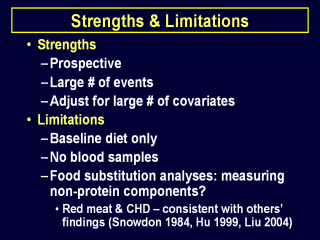| front |1 |2 |3 |4 |5 |6 |7 |8 |9 |10 |11 |12 |13 |14 |15 |16 |17 |18 |19 |20 |21 |22 |23 |24 |review |
 |
Our study has several strengths. The prospective nature of our data collection eliminates any biases associated with recall of diet and lifestyle behaviors. The use of a large, well-defined sample derived from a general population permits the generalizability of our findings, at least to older Caucasian females. Further, we were able to adjust for multiple confounding and potential risk factors. Our study also has potential limitations. First, diet was assessed once in 1986 and dietary changes may have occurred from the baseline period to the present, possibly biasing our associations. However, if this were the case we would not have expected to see different associations of protein intake for the different outcomes. Second, we were not able to assess CHD incidence because the Iowa Women’s Health Study has traditionally focused on collecting information on cancer incidence. Third, we were unable to examine whether intermediate variables, such as serum lipid, glucose or insulin concentrations, could account for the associations we found, as reported in the short-term metabolic studies that replaced dietary protein for carbohydrate Fourth, in performing food substitution analyses, we may also be measuring the effect on CHD mortality and other outcomes of non-protein components of these foods. We controlled for dietary fats, cholesterol, methionine, fiber, as well as multivitamin & vitamin E supplement use to better isolate the effect on our outcomes of the protein in these foods separate from the effects of other nutrients that have established associations with our outcomes Despite the limitations of this approach, we performed these analyses because these substitutions realistically represent typical dietary changes. |